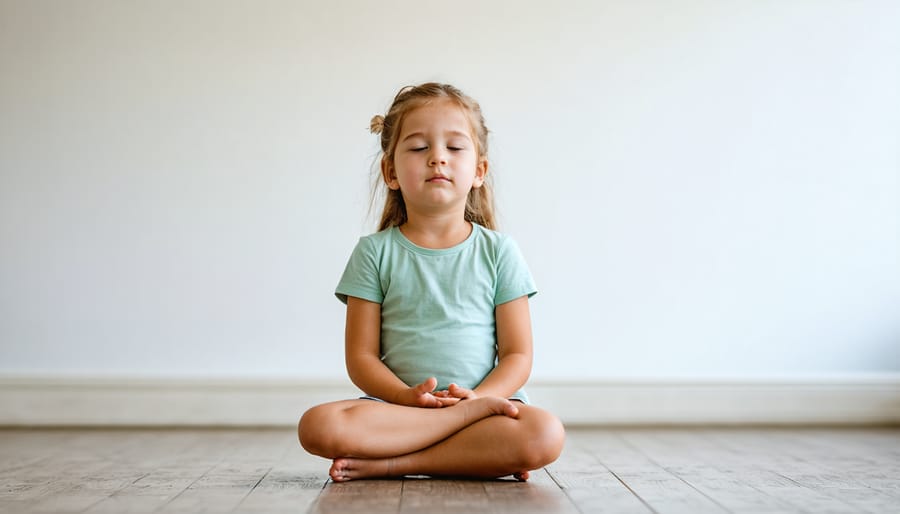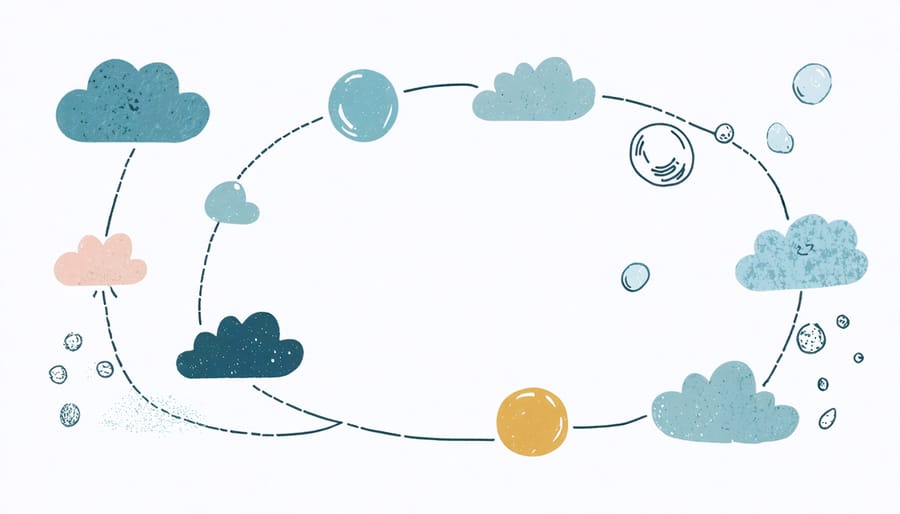Discover the gentle power of 4-7-8 breathing, a transformative mindfulness practice for children and adults alike. This ancient breathing technique, backed by modern science, acts like a natural tranquilizer for your nervous system, helping to calm anxiety, reduce stress, and promote better sleep within minutes.
Think of it as a reset button for your body and mind: breathe in quietly through your nose for 4 seconds, hold that breath for 7 seconds, then release it slowly through your mouth for 8 seconds, making a soft whooshing sound. This simple pattern activates your body’s relaxation response, slowing your heart rate and calming racing thoughts.
Dr. Andrew Weil, who popularized this method, describes it as “the most powerful anti-anxiety tool I’ve found in my 40+ years of practicing integrative medicine.” Parents and educators consistently report remarkable results when teaching this technique to children, especially during bedtime routines or before challenging situations like tests or performances.
Best of all, this method requires no special equipment or preparation – just a quiet moment and the willingness to breathe mindfully. Whether you’re a parent seeking to help your child manage anxiety or an educator looking for classroom calming techniques, the 4-7-8 breathing method offers a practical, science-backed approach to emotional regulation.
Why Children Need Mindful Breathing
In today’s fast-paced world, children face numerous stressors that can impact their emotional well-being. From academic pressures and social challenges to family dynamics and digital overload, these factors can manifest as signs of anxiety in children that shouldn’t be overlooked. Just like adults, kids need effective tools to manage their emotions and find calm in challenging moments.
Mindful breathing exercises, particularly the 4-7-8 method, offer children a practical way to regulate their nervous system and handle stress. When children feel overwhelmed, their breathing often becomes shallow and rapid, triggering their body’s fight-or-flight response. This natural reaction can make it difficult for them to think clearly, focus on tasks, or respond appropriately to situations.
Dr. Sarah Chen, a child psychologist, explains, “Teaching children breathing techniques early on helps them develop crucial self-regulation skills. It’s like giving them an emotional first-aid kit they can carry with them anywhere.”
The beauty of mindful breathing lies in its simplicity and accessibility. Children can practice these exercises anywhere – before a test, during conflicts with siblings, or when feeling overwhelmed by big emotions. Regular practice helps strengthen their ability to self-soothe and builds resilience against future stressors.
Parents often report significant improvements in their children’s emotional regulation after incorporating breathing exercises into their daily routine. Eight-year-old Maya’s mother shares, “Since learning these techniques, Maya handles her pre-soccer game jitters much better. It’s amazing to see her take deep breaths instead of getting caught up in worry.”

Understanding the 4-7-8 Method
The Basic Steps
Let’s break down the 4-7-8 breathing method into simple steps that you can practice with your child. Think of it as a magical breathing pattern that helps calm the mind and body.
First, help your child find a comfortable position, either sitting up straight or lying down. Their body should feel relaxed and supported.
Now, follow these easy steps:
1. Start by letting out all the air through the mouth, making a gentle whooshing sound. Some children like to pretend they’re a deflating balloon.
2. Close the mouth and breathe in quietly through the nose while counting to 4 in your head. Children might imagine smelling a favorite flower.
3. Hold that breath while counting to 7. During this time, they can picture holding a big, happy bubble.
4. Finally, exhale completely through the mouth for a count of 8, making that whoosh sound again. Kids often enjoy pretending they’re a dragon breathing out slowly.
Repeat this cycle up to four times when first starting. It’s perfectly fine if your child needs to use shorter counts – the key is maintaining the ratio. Some children find it helpful to use their fingers to keep track of the counts.
Remember, practice makes perfect. The more regularly you and your child practice this technique together, the more natural it becomes. Start with once or twice a day, perhaps before bedtime or during quiet moments.

Making It Fun for Kids
Teaching kids the 4-7-8 breathing technique becomes much more engaging when you turn it into a playful adventure. Try calling it “Dragon’s Peaceful Breath” – inhaling through the nose like a dragon smelling flowers, holding the breath like keeping a magical bubble safe, and exhaling through the mouth like a gentle dragon’s warm breath.
Create a simple story where they’re blowing out birthday candles in slow motion, or pretending to be a balloon slowly filling up with air and then deflating. Using a pinwheel can make the exhale more exciting – challenge them to spin it slowly and steadily with their breath.
For younger children, try the “Sleeping Bunny” approach: breathe in like smelling carrots (4 counts), hold still like a frozen bunny (7 counts), then release a quiet bunny sigh (8 counts). You can also use stuffed animals, placing them on the child’s belly to watch them rise and fall with each breath.
Make it competitive by using a timer or counting together. Reward charts with stickers can encourage regular practice, especially before bedtime or during anxiety-prone situations. Remember to join in – kids love it when adults participate in their games, and it normalizes the practice of mindful breathing as a family activity.
Always keep the atmosphere light and fun, never forcing participation. When children associate breathing exercises with play, they’re more likely to use these skills naturally when needed.
Teaching Your Child 4-7-8 Breathing
Getting Started
Introducing the 4-7-8 breathing method to children requires patience and age-appropriate adaptations. For toddlers and preschoolers (ages 2-5), start by making it playful – pretend to smell flowers (inhale) and blow out birthday candles (exhale). You can also use visual aids like pinwheels or bubbles to demonstrate the breath.
For elementary school children (ages 6-11), introduce the actual numbers gradually. Begin with shorter counts, like 2-3-4, and work up to the full 4-7-8 pattern. Use familiar analogies, such as “breathing like a sleepy dragon” or “filling up a balloon slowly.”
Older children and teens can learn the complete technique but may need help staying focused. Encourage them to practice while lying down initially, and use a timer or guided recording. Some find it helpful to trace the numbers with their finger as they count.
Remember that every child learns differently. Watch for signs of frustration and adjust accordingly. Start with just 2-3 cycles and gradually increase as your child becomes more comfortable with the practice.

Common Challenges and Solutions
While teaching children the 4-7-8 breathing method, you might encounter some common challenges. Many kids initially find it difficult to hold their breath for the full seven seconds or maintain the four-second inhale. That’s perfectly normal! Start with shorter counts and gradually build up to the full sequence as they become more comfortable.
Some children may feel dizzy or lightheaded when first practicing deep breathing. If this happens, encourage them to return to normal breathing and try again with gentler breaths. Kids might also get the giggles or feel silly during practice – embrace this! Making the exercise fun helps maintain their interest.
Another frequent challenge is maintaining focus. Young minds often wander, making it hard to complete the full breathing cycle. Try using visual aids like imagine blowing up a balloon or smelling a flower to keep them engaged. Some children might rush through the counts – using a visual timer or counting together can help them maintain the proper rhythm.
Remember, consistency and patience are key. Celebrate small improvements and keep practice sessions short and enjoyable.
When to Use 4-7-8 Breathing
The 4-7-8 breathing technique is incredibly versatile and can be helpful in many situations that children and adults face daily. This calming method works particularly well during times of stress, anxiety, or when you need to reset your emotional state.
For children experiencing pre-test jitters or performance anxiety, this breathing exercise can help them feel more centered and focused. It’s also excellent for managing big emotions, like frustration during homework time or conflicts with siblings.
Many families find this technique especially valuable as part of their healthy bedtime routines, helping children transition from active play to restful sleep. It’s also beneficial during challenging transitions, like the first day of school or doctor visits.
Parents and teachers can introduce this method during:
– Morning routines to start the day calmly
– After-school wind-down periods
– Before important events or presentations
– During overwhelming situations
– When dealing with anger or frustration
– Times of worry or nervousness
The beauty of 4-7-8 breathing is that it can be practiced anywhere, anytime, without drawing attention. Children can use it quietly at their desk, in the car, or even while waiting in line. Regular practice during calm moments makes it easier to use when actually needed during stressful situations.
The 4-7-8 breathing method is a powerful tool that can transform how children and adults alike handle stress and anxiety. By practicing this technique regularly, you’re giving yourself and your children a natural, accessible way to find calm during challenging moments. Remember that like any skill, breathing exercises become more effective with consistent practice.
Start by incorporating this technique into your daily routine – perhaps during quiet time, before bedtime, or as part of a morning ritual. Many families find it helpful to practice together, making it a shared experience that strengthens family bonds while building emotional resilience.
Don’t worry if it takes time for your child to master the timing or if they need modifications. The key is to maintain a gentle, patient approach and celebrate small progress. Even if the counts aren’t perfect, the simple act of mindful breathing can make a significant difference in managing emotions and reducing stress.
By teaching children this valuable coping skill early on, you’re equipping them with a lifelong tool for emotional regulation and self-care. Keep encouraging practice, stay consistent, and watch as this simple breathing technique becomes second nature to your family’s wellness routine.

